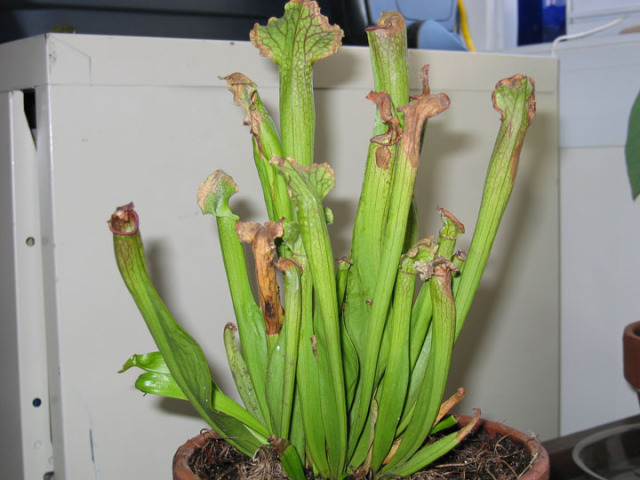Question
 Sick S. Minor
Sick S. Minor
Hello from Rhode Island! I bought a hooded pitcher plant (S. minor) at Whole Foods. It was in a metal container, which starting rusting so I repotted it, but used normal potting soil. (I now know the soil choice was a terrible mistake due to the pH levels and mineral content). About the same time, I also moved the plant to a western window, though it is on a low table and does not get much direct light. The problem is that the pitchers all started browning and folding in on themselves. This extended even to the new pitchers, which continued to sprout but would then brown. After doing some reading, I realize that the potting soil was poisoning the plant so I took it out of the pot and rinsed the whole root system in distilled water. At that time I didn't see any root burns. I repotted in a mix of 3/4 peat moss and 1/4 perlite in a terra cotta pot. Overall it looks healthier, has a brighter green color, and has more new growth but the previous burned ends still linger. Should I trim the burned pitchers off or leave them there? They are unsightly but I want to do what is best for the plant. I am now watering with Poland Springs water - should I switch to distilled only? What else can I do to help this plant make a full recovery?
AnswerHi Ann,
Thank-you for including the photo. That helps so much.
Brace yourself now. There's nothing seriously wrong with your plant. The browned edges are are normal part of old leaves dying off during winter dormancy. Just cut those off. You did the right thing by getting it out of the potting soil. Eventually that would have done it in. Continue to water it with either distilled water, rainwater, melted snow or water purified by reverse osmosis. What carnivorous plants don't like are minerals such as calcium and magnesium; something that springwater can be high in. Go ahead and keep it in a window until spring, probably mid April in your area. After that you should move the plant outside to stay. Also, make sure the plant is always sitting in a small amount of water. The soil should never dry out.
The plant you have is actually a Sarracenia hybrid called Judith Hindle, not Sarracenia minor. All Sarracenia, however, are temperate U.S. native perennials. It could easily handle a Rhode Island winter outside with some protection. It is not a tropical plant. Take a look at our January podcast at http://www.cobraplant.com There you'll see me with some Judith Hindle's under 10 inches of snow.
Once you move it outside, make sure you keep it in water at all times, and in a full sun location. Clip away any old leaves, and ignore any that burn. They'll be replaced by pretty red leaves later. Sarracenia hate shade. For more information on growing Sarracenia, visit our website and go to the caresheet pages. There you'll find detailed information on care.
Good Growing!
Jeff Dallas
Sarracenia Northwest
http://www.cobraplant.com






